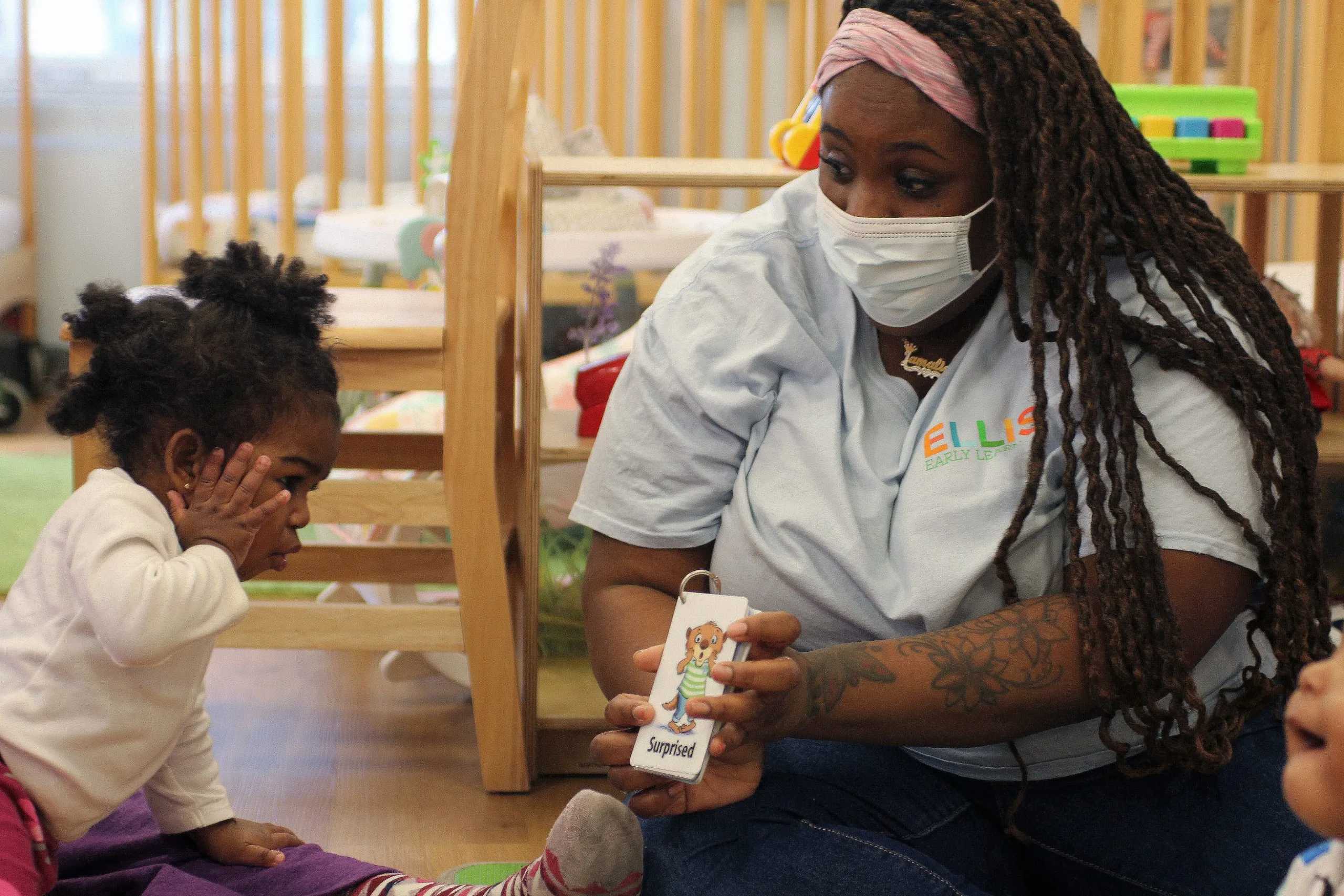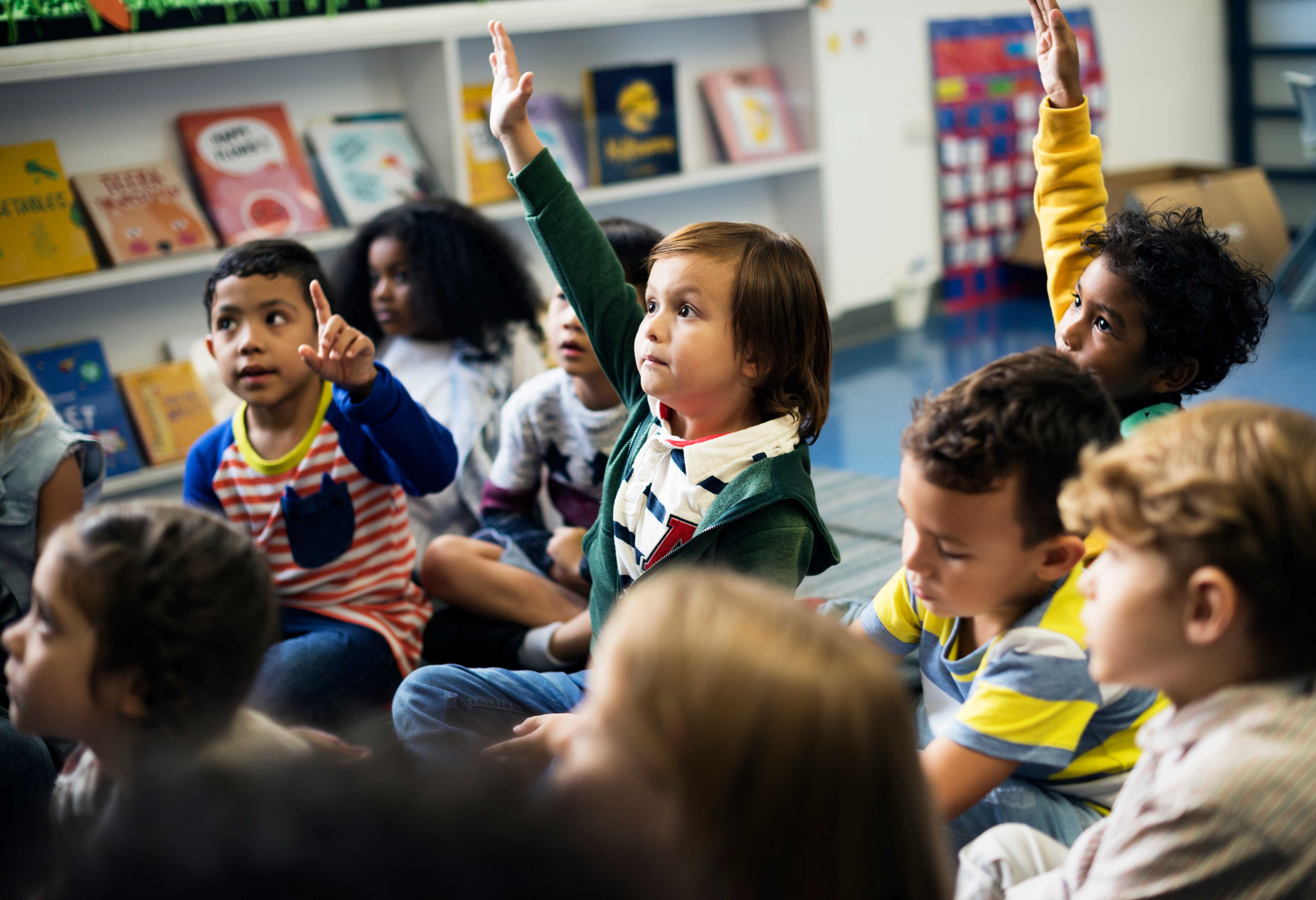“Look, he’s sad!” their teacher said gently as she kneeled next to the 2-year-old. “What can we do to make him feel better?”
One little girl padded over and gently touched his arm. The boy looked up and did what many frustrated, unpredictable toddlers do: He bit her.
As the little girl erupted in tears, the teacher swooped in calmly and hugged her. “You can say, ‘That hurt!’” she instructed. “You need to be gentle,” she reminded the boy.
Biting — and the big emotions that cause it — are commonplace in toddler classrooms. And now, thanks to a new initiative at this Boston-based child care program, teachers have a unified strategy both for addressing the problematic behavior and teaching the toddlers to recognize the underlying emotion behind it.

In previous years, responses to student emotions and conflicts would vary by teacher, often based on training or experiences, said Lauren Cook, chief executive officer at Ellis, which has three locations in the city. In late 2022, Ellis adopted a formal teacher training program, begin to ECSEL, focusing on emotional intelligence for the first time, pairing online training for teachers and classroom-based resources with visits from coaches.
The school is part of a small but growing wave of early learning programs seeking to build or expand their social-emotional component in the wake of a pandemic that has led to more challenging student behavior and unprecedented turnover among child care workers. In Connecticut and New York, for example, home-based child care providers have sought out more formal training in emotional support. More than 250 preschool classrooms in Florida and 150 Head Start classrooms in the northeast have adopted a new emotional curriculum aimed specifically at addressing the pandemic’s toll on young children. And the federal government recently put millions toward expanding emotional intelligence programs in the earliest years.
The need is real. Research and educator surveys show that young children have been severely impacted by pandemic-related stress and trauma, such as the death of loved ones and food and housing security, as well as limited opportunities for social interaction outside of the home. Parents and educators report more young children are hyperactive, fearful, aggressive, and have trouble interacting with peers. Their teachers, too, can benefit tremendously from increased support in coping with sometimes difficult classrooms and behavior.
“Coming out of the pandemic where we’ve seen so much more challenging behavior and just really difficult experiences that the kids have gone through that are showing up in their behavior,” said Cook. “It’s even more important to be devoting time and resources to this.”
Yet even programs for the youngest kids have not escaped some of the broader pushback and controversy, which opponents have accused of promoting critical race theory, the idea that the framework for racism is embedded in society, among other things. Last year in Louisiana, for instance, lawmakers and parents claimed that the state’s new early learning standards might include “potentially divisive concepts,” such as gender identity and systemic racism, within emotional intelligence lessons. (Those standards were approved twice by the state’s top school board, but early this year the school board re-opened public comment.)
“We get to states where, suddenly, [] has become a taboo word to use,” said Mary Louise Hemmeter, a professor of special education at Vanderbilt University. In January, Hemmeter was awarded a nearly $12 million grant from the U.S. Department of Education for the nationwide expansion of a social-emotional learning model that she developed for child care programs, pre-K, and kindergarten classrooms. In some communities, Hemmeter said, she’s very cautious in the language she uses to describe the emotional intelligence programming.

The occasional pushback has not significantly slowed emotional intelligence education's spread for the youngest students, however. Early childhood experts say the goal is quite simple: teaching children basic social, emotional and cognitive skills and how to build empathetic relationships with others.
“If you ask kindergarten teachers what they want children to be able to do when they come to kindergarten, it’s not write their name or know their letters,” Hemmeter said. Kindergarten teachers “want [kids] to be able to follow directions. They want them to be able to persist at difficult tasks. They want them to be able to get along with other kids and work together and be able to engage in classroom routines.”
When Cook and her colleagues at Ellis Early Learning started looking into emotional intelligence training in 2020, they were motivated in part by wanting to ease the transition to elementary school, especially for students who have experienced trauma. More than two-thirds of the program’s families face economic hardship and receive financial assistance from the state to pay tuition. More than 25 percent of children have active cases with the city’s foster care system.

“There are big feelings, there have been traumatic events that kids have witnessed,” said Cook. “We’re giving [kids] autonomy and saying, ‘All of your feelings are valid. You get to feel them in a way that is safe for you and others.’”
“We really need to build capacity in these areas earlier so by the time our kids get to K-12, teachers there will have a much easier time, and the child will have a much easier time,” she added.
In any given classroom at Ellis, a visitor will now hear the same refrains echoed throughout the day:
“Use your words!”
“How do you think your friend is feeling?”
“How did that make you feel?”
Each day, teachers ask students to take time to identify their feelings by affixing their picture next to the name of the emotion they’re feeling on a chart. On a recent February morning in a preschool classroom, for example, most of the class chose happy or excited, but one student selected “frustrated.”
This illustration of feelings helps teachers know how to support individual students. They might give a frustrated or angry child a break in a calming corner, for instance. Or they might know to offer up a hug, a song, a chance to play with items from a sensory box or help practicing deep breathing.
The focus on building emotional intelligence starts even before students can walk or talk. In a bright infant classroom, lead infant teacher Jamalia Sheets held up a card with a picture of a cartoon animal showing a sad face. “Look, she’s sad! Can we make a sad face?” Sheets and her two co-teachers all mimicked a sad face and made crying sounds. “Let’s make an angry face,” she said, flipping to another card and modeling an angry face. A 14-month-old toddling around the circle of teachers mimicked the angry face. “Oooh look at that angry face! That’s what I’m talking about,” Sheets said, before moving on to model excitement, worry and surprise.
Teaching emotional competence from birth is a key tenet of “begin to ECSEL,” the program Ellis has adopted. Created by the nonprofit, Boston-based Housman Institute, the approach capitalizes on the rapid brain development that happens in the first few years of life, said Donna Housman, founder of the institute. “When the brain is overwhelmed by negative emotions, it can’t learn,” she said. “Having the skills to deal with and regulate our own emotions calms the brain.”
Ideally, these skills should not be imparted randomly, experts say. “Where it’s done really well, you can see [it's] woven into everyday practices in the classroom,” said Tia Kim, a developmental psychologist and the vice president of education, research and impact for the Committee for Children, which developed a global program called Second Step.


A growing body of research shows the long-term benefits of quality social-emotional learning for children: an increase in academic performance, better classroom behavior and higher levels of well-being as young adults. One study found that low-income children with stronger social problem-solving skills at the start of preschool learned math skills faster.
Moreover, research shows that providing strong social-emotional training to teachers in early learning programs can help lessen chronic and frequent preschool suspensions — if those supports are done right.
“When [] contributes to reducing teacher stress, that could benefit expulsion rates,” said Kate Zinsser, an applied developmental psychologist and associate professor at the University of Illinois, Chicago and the author of “No Longer Welcome: The Epidemic of Expulsion from Early Childhood Education.” But, she added, “poorly implemented [] supports could increase teacher stress.” That poor implementation includes simply handing a teacher “yet another curriculum” without enough training or observations to enable the teacher to roll out emotional intelligence education effectively.
It can be hard for educators to decipher which programs are beneficial and which are not. At Ellis, officials said they were drawn to the Housman Institute’s program due to a clear record of successful outcomes for children, but investigating alternatives can take time.
Cook is already seeing positive signs that the program is having an impact. Students are better able to work through upsetting situations at school. And parents have reported that their children are showing more empathy and curiosity about emotions and can more clearly identify their feelings.


While other industries have rebounded since the pandemic hit, the early childhood industry is still lagging, struggling to find staff and keep classrooms and programs open. Larger policy and economic changes are needed, such as more federal funding and higher pay for teachers, yet some educators say emotional intelligence program can boost teacher mental health and retention, a goal Cook has at Ellis.
“We need this job to be easier for people, because it’s hard,” said Cook. “It can only be easier when we equip them with the right tools so they can manage their class successfully.” She hopes that with the new emphasis on emotional intelligence, “teachers will feel they have a much stronger capacity to manage their classrooms in a healthy, positive way, and also that the children have even better days.”
For Sheets, the infant room teacher, the embrace of emotional intelligence has helped her better regulate her emotions as well as those of her students — making it easier to balance a stressful, physically taxing job and motherhood. The curriculum used by Ellis includes several online teacher training modules on topics like identifying and managing emotions and how to deal with stress. The goal is to help teachers manage their own emotions and mental health first so they can then better help children. “Understanding emotions within yourself, understanding emotions within children helps you go a long way to helping them foster healthy child development,” Sheets said.
It was during one of these online training sessions that Sheets first heard the term “toxic stress,” or long-lasting stress due to frequent or prolonged adversity. Sheets realized then that experiences from what she said was a rough childhood, including five years living apart from her mother, were still impacting some of her emotional responses as an adult. The training has helped her manage her own stress, which translates into how she responds to children and models behavior. “Being able to pick up on certain things that could be stressors and regulate them before you come into the professional environment with them, it’s been very helpful,” she said.
While beneficial to educators, officials at Ellis said their work could be bolstered if parents embraced a similar approach at home to further foster student behavior, emotional intelligence and regulation. “It’s so important because if we’re teaching the children about their social-emotional learning here, and then at home it’s not the same, then there’s not necessarily a balance,” said Cherish Casey, a social worker at Ellis. “I think it will really help the children build their social emotional regulation and emotional identity if it’s a full circle, and the family knows the same tools that we’re teaching them.”
Read the full article on The Hechinger Report, a nonprofit, independent news organization focused on inequality and innovation, or on Ed Post.




